fuel type NISSAN QASHQAI 2014 OwnerôÇs Manual
[x] Cancel search | Manufacturer: NISSAN, Model Year: 2014, Model line: QASHQAI, Model: NISSAN QASHQAI 2014Pages: 338, PDF Size: 4.87 MB
Page 125 of 338
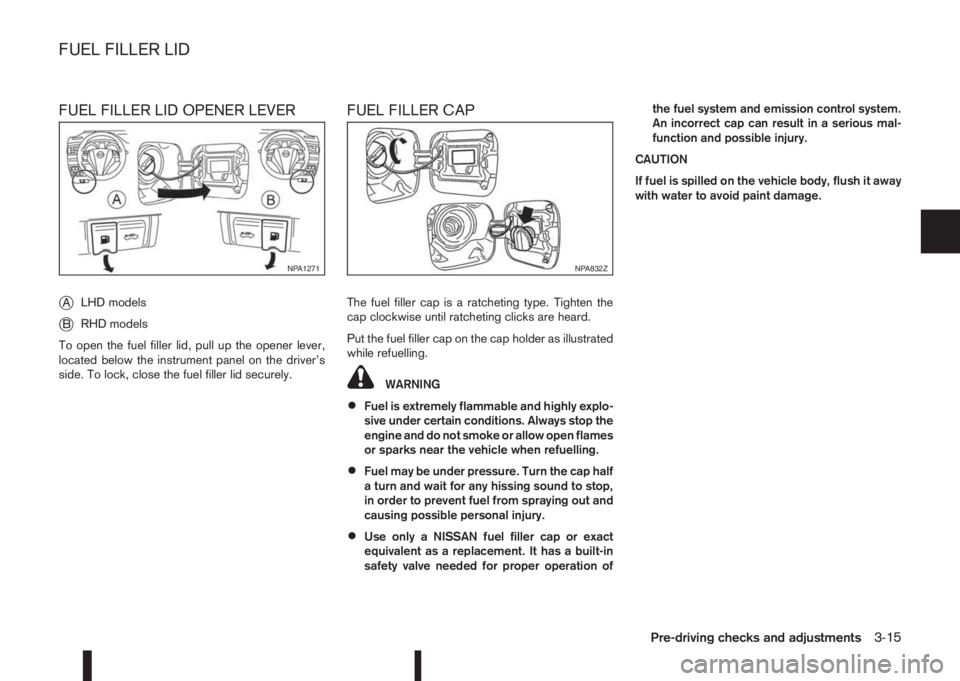
FUEL FILLER LID OPENER LEVER
j
ALHD models
jBRHD models
To open the fuel filler lid, pull up the opener lever,
located below the instrument panel on the driverãs
side. To lock, close the fuel filler lid securely.
FUEL FILLER CAP
The fuel filler cap is a ratcheting type. Tighten the
cap clockwise until ratcheting clicks are heard.
Put the fuel filler cap on the cap holder as illustrated
while refuelling.
WARNING
ãÂFuel is extremely flammable and highly explo-
sive under certain conditions. Always stop the
engine and do not smoke or allow open flames
or sparks near the vehicle when refuelling.
ãÂFuel may be under pressure. Turn the cap half
a turn and wait for any hissing sound to stop,
in order to prevent fuel from spraying out and
causing possible personal injury.
ãÂUse only a NISSAN fuel filler cap or exact
equivalent as a replacement. It has a built-in
safety valve needed for proper operation ofthe fuel system and emission control system.
An incorrect cap can result in a serious mal-
function and possible injury.
CAUTION
If fuel is spilled on the vehicle body, flush it away
with water to avoid paint damage.
NPA1271NPA832Z
FUEL FILLER LID
Pre-driving checks and adjustments3-15
Page 185 of 338
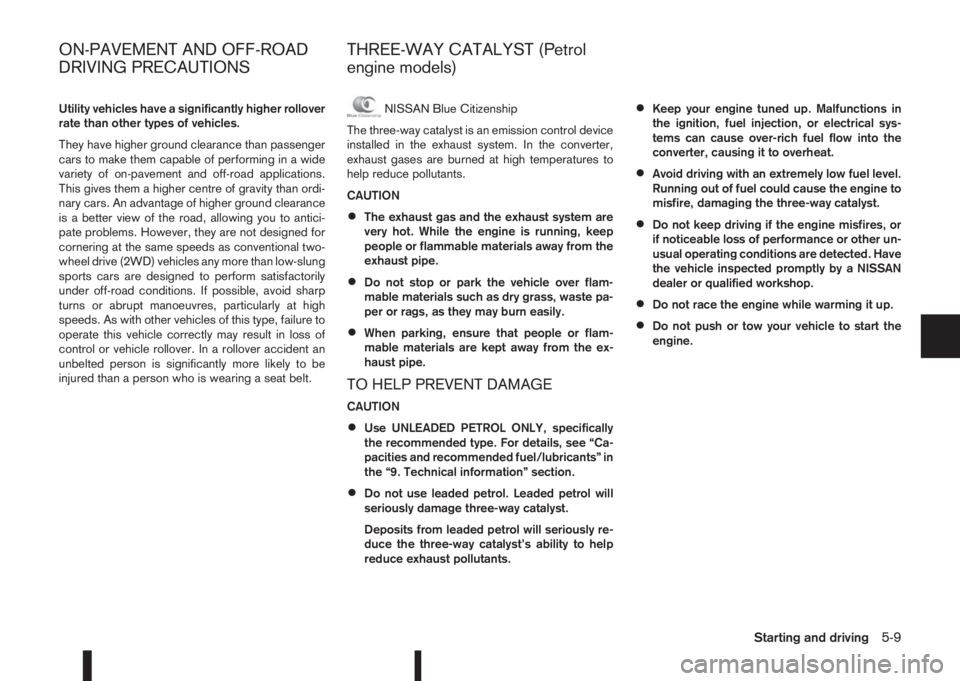
Utility vehicles have a significantly higher rollover
rate than other types of vehicles.
They have higher ground clearance than passenger
cars to make them capable of performing in a wide
variety of on-pavement and off-road applications.
This gives them a higher centre of gravity than ordi-
nary cars. An advantage of higher ground clearance
is a better view of the road, allowing you to antici-
pate problems. However, they are not designed for
cornering at the same speeds as conventional two-
wheel drive (2WD) vehicles any more than low-slung
sports cars are designed to perform satisfactorily
under off-road conditions. If possible, avoid sharp
turns or abrupt manoeuvres, particularly at high
speeds. As with other vehicles of this type, failure to
operate this vehicle correctly may result in loss of
control or vehicle rollover. In a rollover accident an
unbelted person is significantly more likely to be
injured than a person who is wearing a seat belt.NISSAN Blue Citizenship
The three-way catalyst is an emission control device
installed in the exhaust system. In the converter,
exhaust gases are burned at high temperatures to
help reduce pollutants.
CAUTION
ãÂThe exhaust gas and the exhaust system are
very hot. While the engine is running, keep
people or flammable materials away from the
exhaust pipe.
ãÂDo not stop or park the vehicle over flam-
mable materials such as dry grass, waste pa-
per or rags, as they may burn easily.
ãÂWhen parking, ensure that people or flam-
mable materials are kept away from the ex-
haust pipe.
TO HELP PREVENT DAMAGE
CAUTION
ãÂUse UNLEADED PETROL ONLY, specifically
the recommended type. For details, see ãCa-
pacities and recommended fuel/lubricantsã in
the ã9. Technical informationã section.
ãÂDo not use leaded petrol. Leaded petrol will
seriously damage three-way catalyst.
Deposits from leaded petrol will seriously re-
duce the three-way catalystãs ability to help
reduce exhaust pollutants.
ãÂKeep your engine tuned up. Malfunctions in
the ignition, fuel injection, or electrical sys-
tems can cause over-rich fuel flow into the
converter, causing it to overheat.
ãÂAvoid driving with an extremely low fuel level.
Running out of fuel could cause the engine to
misfire, damaging the three-way catalyst.
ãÂDo not keep driving if the engine misfires, or
if noticeable loss of performance or other un-
usual operating conditions are detected. Have
the vehicle inspected promptly by a NISSAN
dealer or qualified workshop.
ãÂDo not race the engine while warming it up.
ãÂDo not push or tow your vehicle to start the
engine.
ON-PAVEMENT AND OFF-ROAD
DRIVING PRECAUTIONSTHREE-WAY CATALYST (Petrol
engine models)
Starting and driving5-9
Page 268 of 338
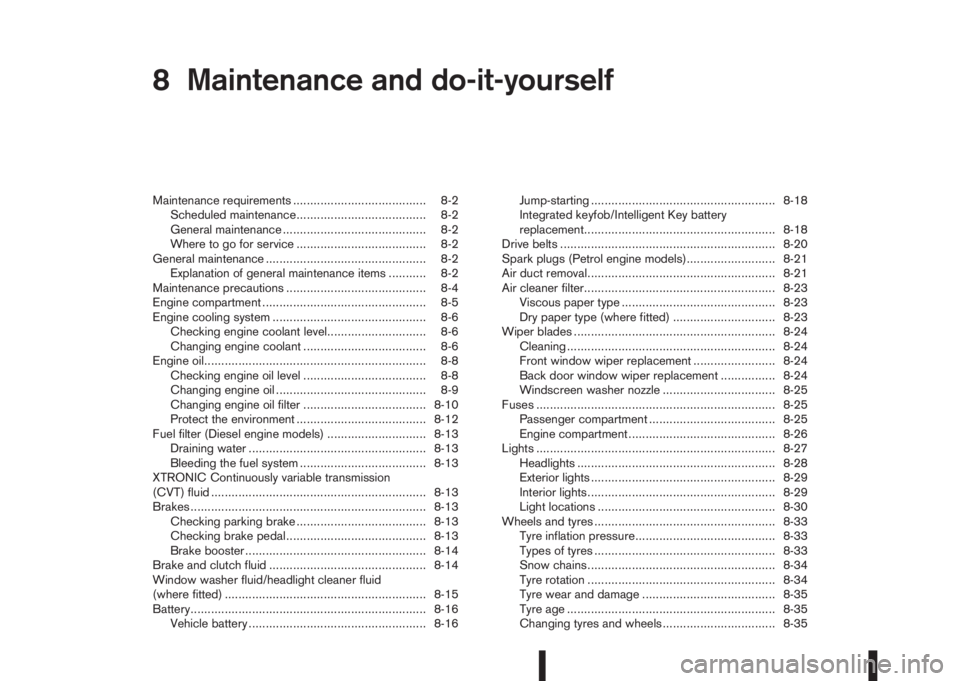
8Maintenance and do-it-yourselfMaintenance and do-it-yourself
Maintenance requirements ....................................... 8-2
Scheduled maintenance...................................... 8-2
General maintenance .......................................... 8-2
Where to go for service ...................................... 8-2
General maintenance ............................................... 8-2
Explanation of general maintenance items ........... 8-2
Maintenance precautions ......................................... 8-4
Engine compartment ................................................ 8-5
Engine cooling system ............................................. 8-6
Checking engine coolant level............................. 8-6
Changing engine coolant .................................... 8-6
Engine oil................................................................. 8-8
Checking engine oil level .................................... 8-8
Changing engine oil ............................................ 8-9
Changing engine oil filter .................................... 8-10
Protect the environment ...................................... 8-12
Fuel filter (Diesel engine models) ............................. 8-13
Draining water .................................................... 8-13
Bleeding the fuel system ..................................... 8-13
XTRONIC Continuously variable transmission
(CVT) fluid ............................................................... 8-13
Brakes ..................................................................... 8-13
Checking parking brake ...................................... 8-13
Checking brake pedal......................................... 8-13
Brake booster ..................................................... 8-14
Brake and clutch fluid .............................................. 8-14
Window washer fluid/headlight cleaner fluid
(where fitted) ........................................................... 8-15
Battery..................................................................... 8-16
Vehicle battery .................................................... 8-16Jump-starting ...................................................... 8-18
Integrated keyfob/Intelligent Key battery
replacement........................................................ 8-18
Drive belts ............................................................... 8-20
Spark plugs (Petrol engine models).......................... 8-21
Air duct removal....................................................... 8-21
Air cleaner filter........................................................ 8-23
Viscous paper type ............................................. 8-23
Dry paper type (where fitted) .............................. 8-23
Wiper blades ........................................................... 8-24
Cleaning ............................................................. 8-24
Front window wiper replacement ........................ 8-24
Back door window wiper replacement ................ 8-24
Windscreen washer nozzle ................................. 8-25
Fuses ...................................................................... 8-25
Passenger compartment ..................................... 8-25
Engine compartment ........................................... 8-26
Lights ...................................................................... 8-27
Headlights .......................................................... 8-28
Exterior lights ...................................................... 8-29
Interior lights....................................................... 8-29
Light locations .................................................... 8-30
Wheels and tyres ..................................................... 8-33
Tyre inflation pressure......................................... 8-33
Types of tyres ..................................................... 8-33
Snow chains....................................................... 8-34
Tyre rotation ....................................................... 8-34
Tyre wear and damage ....................................... 8-35
Tyre age ............................................................. 8-35
Changing tyres and wheels................................. 8-35
Page 279 of 338
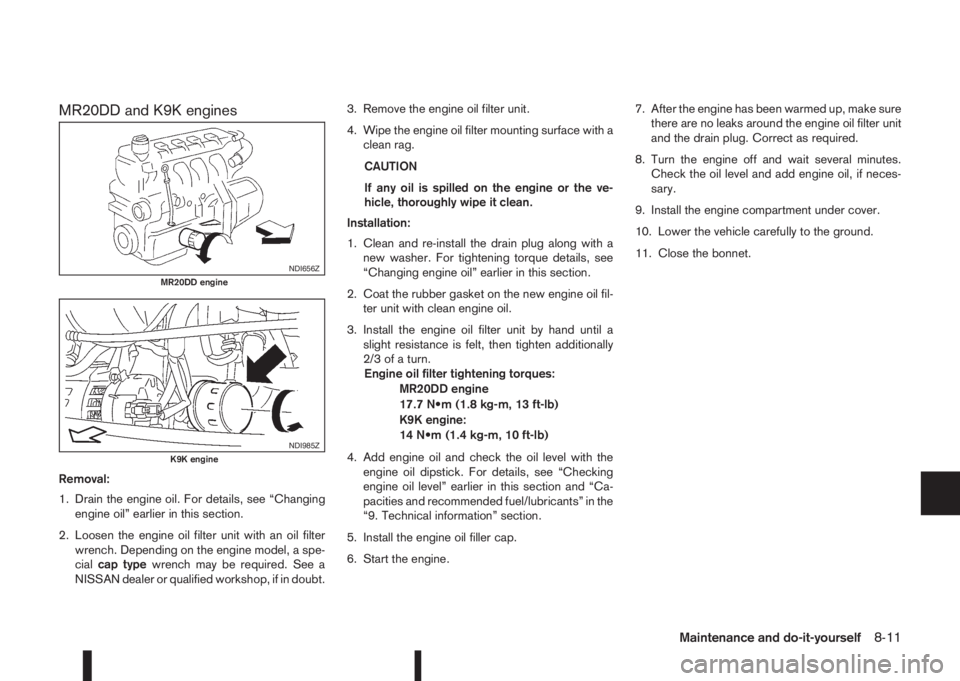
MR20DD and K9K engines
Removal:
1. Drain the engine oil. For details, see ãChanging
engine oilã earlier in this section.
2. Loosen the engine oil filter unit with an oil filter
wrench. Depending on the engine model, a spe-
cialcap typewrench may be required. See a
NISSAN dealer or qualified workshop, if in doubt.3. Remove the engine oil filter unit.
4. Wipe the engine oil filter mounting surface with a
clean rag.
CAUTION
If any oil is spilled on the engine or the ve-
hicle, thoroughly wipe it clean.
Installation:
1. Clean and re-install the drain plug along with a
new washer. For tightening torque details, see
ãChanging engine oilã earlier in this section.
2. Coat the rubber gasket on the new engine oil fil-
ter unit with clean engine oil.
3. Install the engine oil filter unit by hand until a
slight resistance is felt, then tighten additionally
2/3 of a turn.
Engine oil filter tightening torques:
MR20DD engine
17.7 NãÂm (1.8 kg-m, 13 ft-lb)
K9K engine:
14 NãÂm (1.4 kg-m, 10 ft-lb)
4. Add engine oil and check the oil level with the
engine oil dipstick. For details, see ãChecking
engine oil levelã earlier in this section and ãCa-
pacities and recommended fuel/lubricantsã in the
ã9. Technical informationã section.
5. Install the engine oil filler cap.
6. Start the engine.7. After the engine has been warmed up, make sure
there are no leaks around the engine oil filter unit
and the drain plug. Correct as required.
8. Turn the engine off and wait several minutes.
Check the oil level and add engine oil, if neces-
sary.
9. Install the engine compartment under cover.
10. Lower the vehicle carefully to the ground.
11. Close the bonnet.
NDI656ZMR20DD engine
NDI985ZK9K engine
Maintenance and do-it-yourself8-11
Page 283 of 338
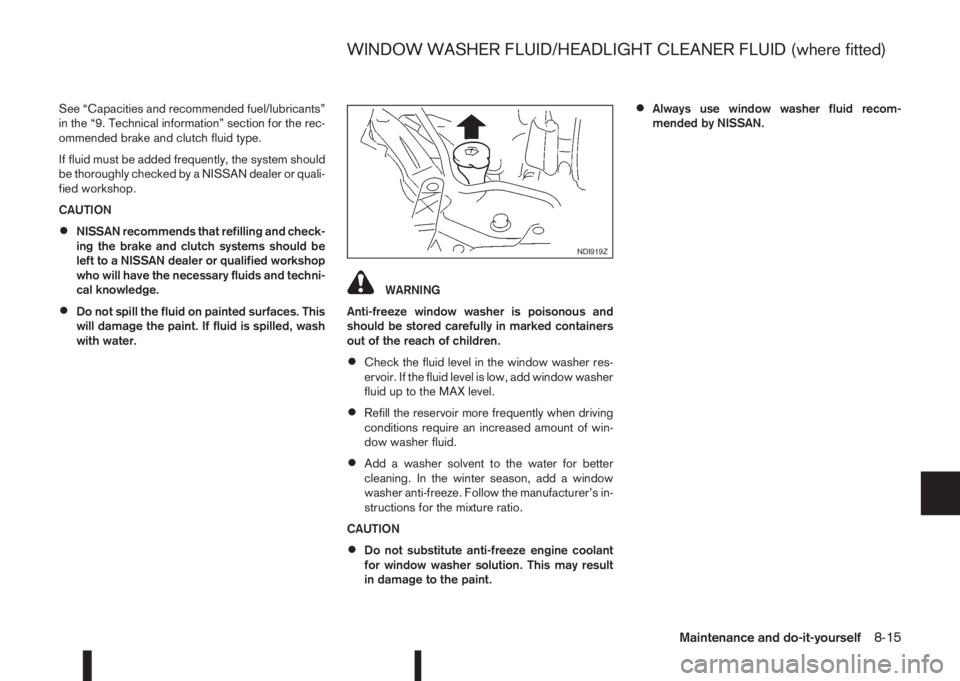
See ãCapacities and recommended fuel/lubricantsã
in the ã9. Technical informationã section for the rec-
ommended brake and clutch fluid type.
If fluid must be added frequently, the system should
be thoroughly checked by a NISSAN dealer or quali-
fied workshop.
CAUTION
ãÂNISSAN recommends that refilling and check-
ing the brake and clutch systems should be
left to a NISSAN dealer or qualified workshop
who will have the necessary fluids and techni-
cal knowledge.
ãÂDo not spill the fluid on painted surfaces. This
will damage the paint. If fluid is spilled, wash
with water.
WARNING
Anti-freeze window washer is poisonous and
should be stored carefully in marked containers
out of the reach of children.
ãÂCheck the fluid level in the window washer res-
ervoir. If the fluid level is low, add window washer
fluid up to the MAX level.
ãÂRefill the reservoir more frequently when driving
conditions require an increased amount of win-
dow washer fluid.
ãÂAdd a washer solvent to the water for better
cleaning. In the winter season, add a window
washer anti-freeze. Follow the manufacturerãs in-
structions for the mixture ratio.
CAUTION
ãÂDo not substitute anti-freeze engine coolant
for window washer solution. This may result
in damage to the paint.
ãÂAlways use window washer fluid recom-
mended by NISSAN.
NDI919Z
WINDOW WASHER FLUID/HEADLIGHT CLEANER FLUID (where fitted)
Maintenance and do-it-yourself8-15
Page 308 of 338
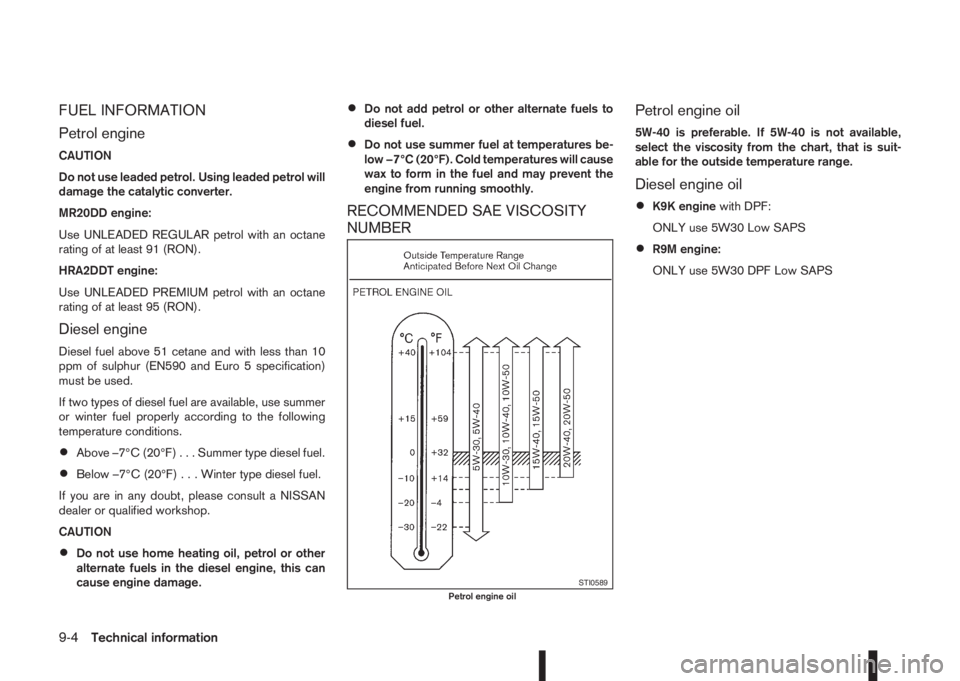
FUEL INFORMATION
Petrol engine
CAUTION
Do not use leaded petrol. Using leaded petrol will
damage the catalytic converter.
MR20DD engine:
Use UNLEADED REGULAR petrol with an octane
rating of at least 91 (RON).
HRA2DDT engine:
Use UNLEADED PREMIUM petrol with an octane
rating of at least 95 (RON).
Diesel engine
Diesel fuel above 51 cetane and with less than 10
ppm of sulphur (EN590 and Euro 5 specification)
must be used.
If two types of diesel fuel are available, use summer
or winter fuel properly according to the following
temperature conditions.
ãÂAbove ã7ô¯C (20ô¯F)...Summer type diesel fuel.
ãÂBelowã7ô¯C(20ô¯F)...Wintertypedieselfuel.
If you are in any doubt, please consult a NISSAN
dealer or qualified workshop.
CAUTION
ãÂDo not use home heating oil, petrol or other
alternate fuels in the diesel engine, this can
cause engine damage.
ãÂDo not add petrol or other alternate fuels to
diesel fuel.
ãÂDo not use summer fuel at temperatures be-
low ã7ô¯C (20ô¯F). Cold temperatures will cause
wax to form in the fuel and may prevent the
engine from running smoothly.
RECOMMENDED SAE VISCOSITY
NUMBERPetrol engine oil
5W-40 is preferable. If 5W-40 is not available,
select the viscosity from the chart, that is suit-
able for the outside temperature range.
Diesel engine oil
ãÂK9K enginewith DPF:
ONLY use 5W30 Low SAPS
ãÂR9M engine:
ONLY use 5W30 DPF Low SAPS
STI0589Petrol engine oil
9-4Technical information
Page 310 of 338
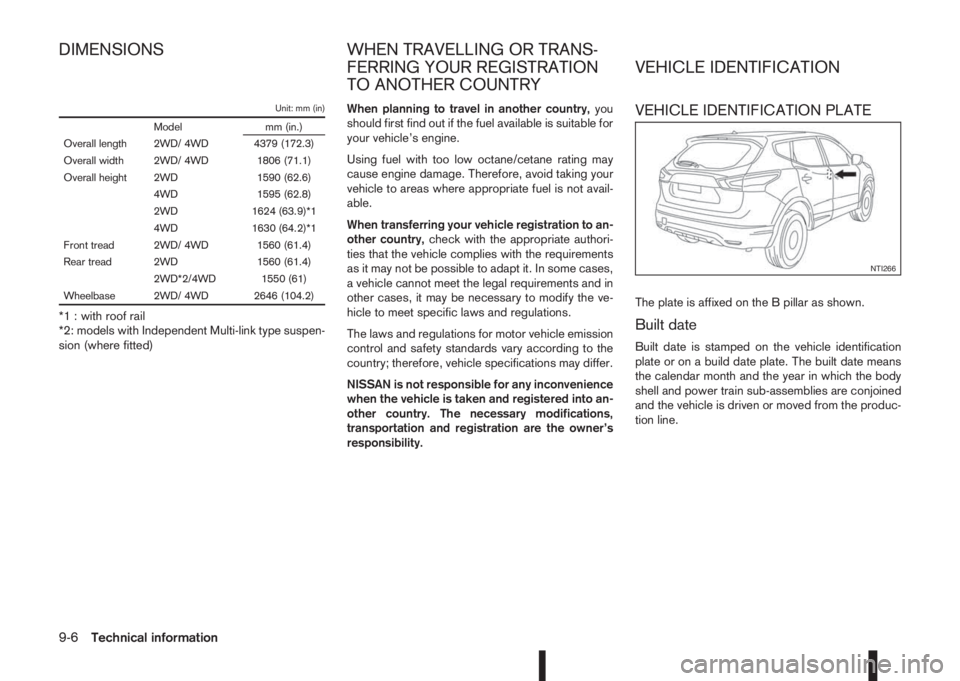
Unit: mm (in)
Model mm (in.)
Overall length 2WD/ 4WD 4379 (172.3)
Overall width 2WD/ 4WD 1806 (71.1)
Overall height 2WD 1590 (62.6)
4WD 1595 (62.8)
2WD 1624 (63.9)*1
4WD 1630 (64.2)*1
Front tread 2WD/ 4WD 1560 (61.4)
Rear tread 2WD 1560 (61.4)
2WD*2/4WD 1550 (61)
Wheelbase 2WD/ 4WD 2646 (104.2)
*1 : with roof rail
*2: models with Independent Multi-link type suspen-
sion (where fitted)When planning to travel in another country,you
should first find out if the fuel available is suitable for
your vehicleãs engine.
Using fuel with too low octane/cetane rating may
cause engine damage. Therefore, avoid taking your
vehicle to areas where appropriate fuel is not avail-
able.
When transferring your vehicle registration to an-
other country,check with the appropriate authori-
ties that the vehicle complies with the requirements
as it may not be possible to adapt it. In some cases,
a vehicle cannot meet the legal requirements and in
other cases, it may be necessary to modify the ve-
hicle to meet specific laws and regulations.
The laws and regulations for motor vehicle emission
control and safety standards vary according to the
country; therefore, vehicle specifications may differ.
NISSAN is not responsible for any inconvenience
when the vehicle is taken and registered into an-
other country. The necessary modifications,
transportation and registration are the ownerãs
responsibility.
VEHICLE IDENTIFICATION PLATE
The plate is affixed on the B pillar as shown.
Built date
Built date is stamped on the vehicle identification
plate or on a build date plate. The built date means
the calendar month and the year in which the body
shell and power train sub-assemblies are conjoined
and the vehicle is driven or moved from the produc-
tion line.
NTI266
DIMENSIONS WHEN TRAVELLING OR TRANS-
FERRING YOUR REGISTRATION
TO ANOTHER COUNTRYVEHICLE IDENTIFICATION
9-6Technical information
Page 322 of 338
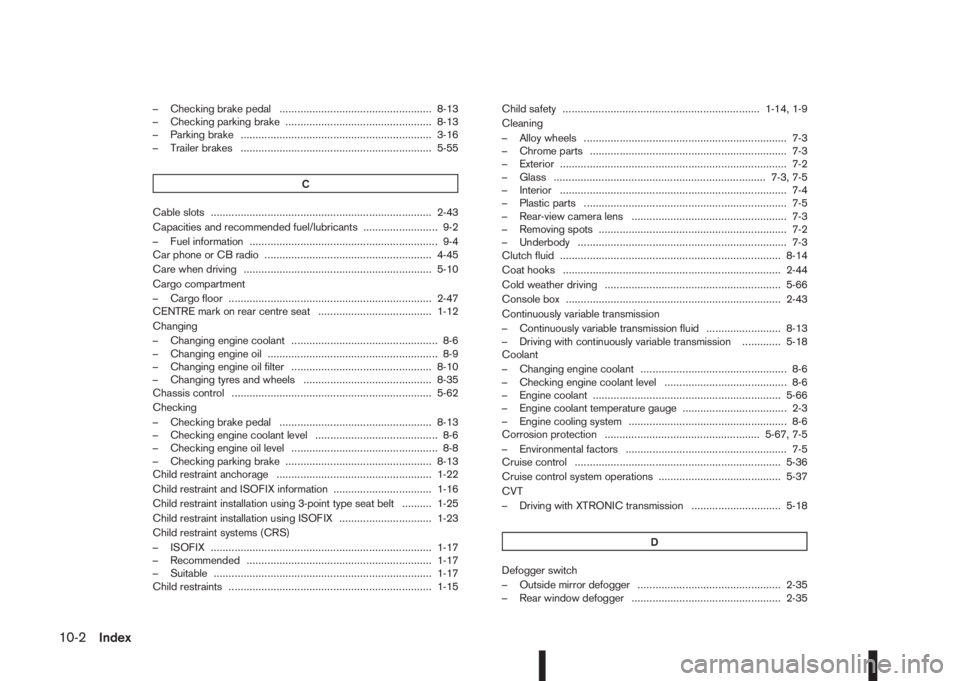
ã Checking brake pedal ................................................... 8-13
ã Checking parking brake ................................................. 8-13
ã Parking brake ................................................................ 3-16
ã Trailer brakes ................................................................ 5-55
C
Cable slots .......................................................................... 2-43
Capacities and recommended fuel/lubricants ......................... 9-2
ã Fuel information ............................................................... 9-4
Car phone or CB radio ........................................................ 4-45
Care when driving ............................................................... 5-10
Cargo compartment
ã Cargo floor .................................................................... 2-47
CENTRE mark on rear centre seat ...................................... 1-12
Changing
ã Changing engine coolant ................................................. 8-6
ã Changing engine oil ......................................................... 8-9
ã Changing engine oil filter ............................................... 8-10
ã Changing tyres and wheels ........................................... 8-35
Chassis control ................................................................... 5-62
Checking
ã Checking brake pedal ................................................... 8-13
ã Checking engine coolant level ......................................... 8-6
ã Checking engine oil level ................................................. 8-8
ã Checking parking brake ................................................. 8-13
Child restraint anchorage .................................................... 1-22
Child restraint and ISOFIX information ................................. 1-16
Child restraint installation using 3-point type seat belt .......... 1-25
Child restraint installation using ISOFIX ............................... 1-23
Child restraint systems (CRS)
ã ISOFIX .......................................................................... 1-17
ã Recommended .............................................................. 1-17
ã Suitable ......................................................................... 1-17
Child restraints .................................................................... 1-15Child safety .................................................................. 1-14, 1-9
Cleaning
ã Alloy wheels .................................................................... 7-3
ã Chrome parts .................................................................. 7-3
ã Exterior ............................................................................ 7-2
ã Glass ....................................................................... 7-3, 7-5
ã Interior ............................................................................ 7-4
ã Plastic parts .................................................................... 7-5
ã Rear-view camera lens .................................................... 7-3
ã Removing spots ............................................................... 7-2
ã Underbody ...................................................................... 7-3
Clutch fluid .......................................................................... 8-14
Coat hooks ......................................................................... 2-44
Cold weather driving ........................................................... 5-66
Console box ........................................................................ 2-43
Continuously variable transmission
ã Continuously variable transmission fluid ......................... 8-13
ã Driving with continuously variable transmission ............. 5-18
Coolant
ã Changing engine coolant ................................................. 8-6
ã Checking engine coolant level ......................................... 8-6
ã Engine coolant ............................................................... 5-66
ã Engine coolant temperature gauge ................................... 2-3
ã Engine cooling system ..................................................... 8-6
Corrosion protection .................................................... 5-67, 7-5
ã Environmental factors ...................................................... 7-5
Cruise control ..................................................................... 5-36
Cruise control system operations ......................................... 5-37
CVT
ã Driving with XTRONIC transmission .............................. 5-18
D
Defogger switch
ã Outside mirror defogger ................................................ 2-35
ã Rear window defogger .................................................. 2-35
10-2Index